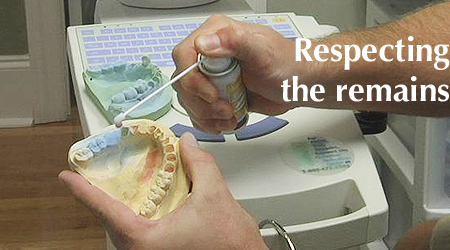Research by Dr. Shannon Hodge, assistant professor of anthropology at MTSU, could provide archaeologists with a new way to investigate the past while respecting the wishes of living Native Americans for the treatment of their ancestors’ remains.

Dr. Shannon Hodge
“The human skeletal remains contained in these burials can be closely examined to reveal patterns of past health and nutrition and to illuminate some of the social, economic and political impact on past people’s lives,” notes Hodge.
With existing computer-aided technology used by dentists for restorations such as crowns, Hodge produced replicas of human teeth for study so that the natural teeth could be returned to the grave.
“Each natural tooth and replica were … compared under a scanning electron microscope to see if the copy was accurate enough to stand in for the original,” Hodge says. “We discovered that the technique works very well.”
In fact, Hodge learned that the surface features on the replica teeth were reproduced at a level of detail even smaller than surface features produced on natural teeth by damage, disease or cultural modification.

A technician works with a replica of human teeth found in a Native American burial site to discover information about patterns of health and nutrition. Using dental technology to replicate the remains allows them to be returned to their proper burial location. (photo submitted)
Under the 1990 Native American Graves Protection and Repatriation Act, skeletal remains of Native Americans and their funerary objects can be repatriated to Native American descendants of the dead. The remains and artifacts often are reburied out of respect for tribal traditions, but that means they’re also permanently removed from academic study.
“We are proud to report that, for prehistoric human skeletal remains, this technique can provide one approach to preserving irreplaceable scientific data while also respecting Native America’s call for timely repatriation,” Hodge explains.
Hodge’s research was funded by a $23,282 grant from the National Park Service’s National Center for Preservation Training and Technology and a matching amount from the MTSU Office of Sponsored Research.
For more information, contact Hodge at 615-494-7681 or shannon.hodge@mtsu.edu.
— Gina K. Logue (Gina.Logue@mtsu.edu)


COMMENTS ARE OFF THIS POST